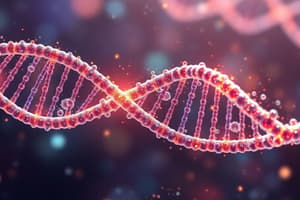Podcast
Questions and Answers
What is the main function of restriction enzymes?
What is the main function of restriction enzymes?
- To promote the formation of blunt ends in DNA sequences
- To enhance the uptake and replication of alien genetic material
- To create supercoiling in DNA strands
- To prevent the uptake and replication of alien genetic material (correct)
Which type of restriction enzyme recognizes specific DNA sequences and cleaves both strands, creating blunt ends or staggered ends with overhangs?
Which type of restriction enzyme recognizes specific DNA sequences and cleaves both strands, creating blunt ends or staggered ends with overhangs?
- Type I enzymes
- Class III enzymes
- Class I enzymes
- Type II enzymes (correct)
What is the characteristic feature of Class 12 restriction enzymes compared to Class I and Class III enzymes?
What is the characteristic feature of Class 12 restriction enzymes compared to Class I and Class III enzymes?
- They cleave DNA only after supercoiling
- They primarily create staggered ends with overhangs
- They recognize specific DNA sequences and cleave both strands (correct)
- They are the most abundant and versatile group of restriction enzymes
What is the significance of the unique recognition site of each restriction enzyme?
What is the significance of the unique recognition site of each restriction enzyme?
Which two frequently used Class 12 enzymes are mentioned in the text?
Which two frequently used Class 12 enzymes are mentioned in the text?
Which type of ends does BamHI generate after cleaving the DNA?
Which type of ends does BamHI generate after cleaving the DNA?
What is the recognition sequence for EcoRI?
What is the recognition sequence for EcoRI?
How are Class 12 restriction enzymes used in DNA cloning?
How are Class 12 restriction enzymes used in DNA cloning?
What is the primary function of Class 12 restriction enzymes in DNA mutagenesis?
What is the primary function of Class 12 restriction enzymes in DNA mutagenesis?
How do Class 12 restriction enzymes contribute to DNA recombination?
How do Class 12 restriction enzymes contribute to DNA recombination?
Flashcards are hidden until you start studying
Study Notes
Exploring Restriction Enzymes Class 12: Function, Types, and Applications
In the realm of molecular biology, restriction enzymes are essential tools that play a pivotal role in genetic manipulation and analysis. Restriction enzymes, specifically class 12 enzymes, are a type of endonuclease that recognizes and cuts specific DNA sequences. Here, we'll delve into the function, types, and applications of these remarkable enzymes.
Function
Restriction enzymes, also known as restriction endonucleases, were discovered in the 1960s as bacterial defense mechanisms against foreign DNA, like that from viruses. They recognize and cleave specific DNA sequences, which are unique across different species, to prevent the uptake and replication of alien genetic material.
Class 12 enzymes are a subset of the Type II restriction enzymes, which represent the most abundant and versatile group of restriction enzymes. Unlike Class I and Class III enzymes that cleave DNA only after supercoiling, Class 2 enzymes recognize specific DNA sequences and cleave both strands, creating blunt ends or staggered ends with overhangs.
Types
There are several hundred different restriction enzymes identified to date, each with a unique recognition site. They are classified according to their recognition site and cleavage pattern. For instance, EcoRI and BamHI are two frequently used Class 12 enzymes.
- EcoRI: EcoRI is isolated from Escherichia coli RY13. Its recognition site is a 6-bp sequence (GAATTC) and it cleaves the DNA between the 4th and 5th nucleotides, creating blunt ends.
- BamHI: BamHI, also from E. coli, has a 6-bp recognition site (GGATCC) and cleaves the DNA between the 4th and 5th nucleotides, generating staggered ends with one 4-bp overhang.
Applications
The versatility and specificity of Class 12 restriction enzymes have made them indispensable tools in molecular biology.
- DNA fragmentation: Class 12 enzymes are used to cut DNA into smaller, more manageable fragments for analysis.
- DNA cloning: Restriction enzymes are employed to insert foreign DNA into a plasmid or another vector for cloning purposes.
- DNA sequencing: Restriction enzymes are used to generate smaller DNA fragments that are then sequenced, which helps to determine the order of nucleotides in a specific genome.
- DNA mutagenesis: Class 12 enzymes are used to cut DNA at specific sites, which can be used to introduce mutations into a particular gene for functional or experimental purposes.
- DNA recombination: Restriction enzymes are used to exchange DNA segments between two vectors or DNA molecules.
- DNA repair: In bacteria, Class 12 enzymes are used to recognize and repair damaged DNA by cutting out the damaged region and replacing it with undamaged DNA.
In summary, Class 12 restriction enzymes are essential tools in molecular biology that recognize and cleave specific DNA sequences with great specificity. They are used for DNA fragmentation, cloning, sequencing, mutagenesis, recombination, and DNA repair. With over 400 different enzymes identified, they offer a vast array of options to handle virtually any molecular biology challenge.
Studying That Suits You
Use AI to generate personalized quizzes and flashcards to suit your learning preferences.




